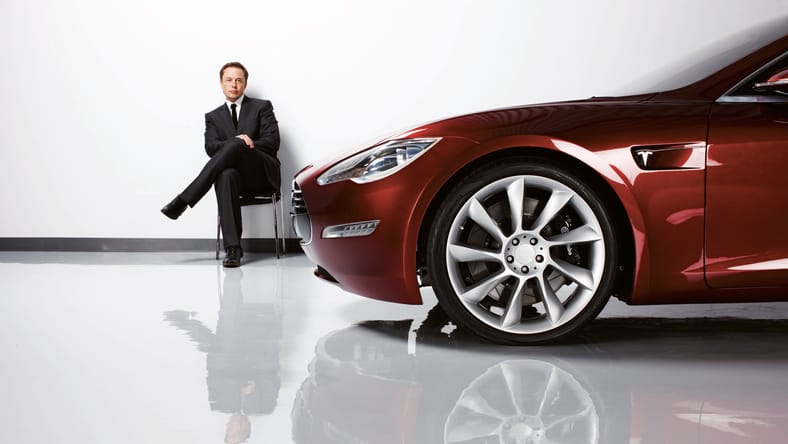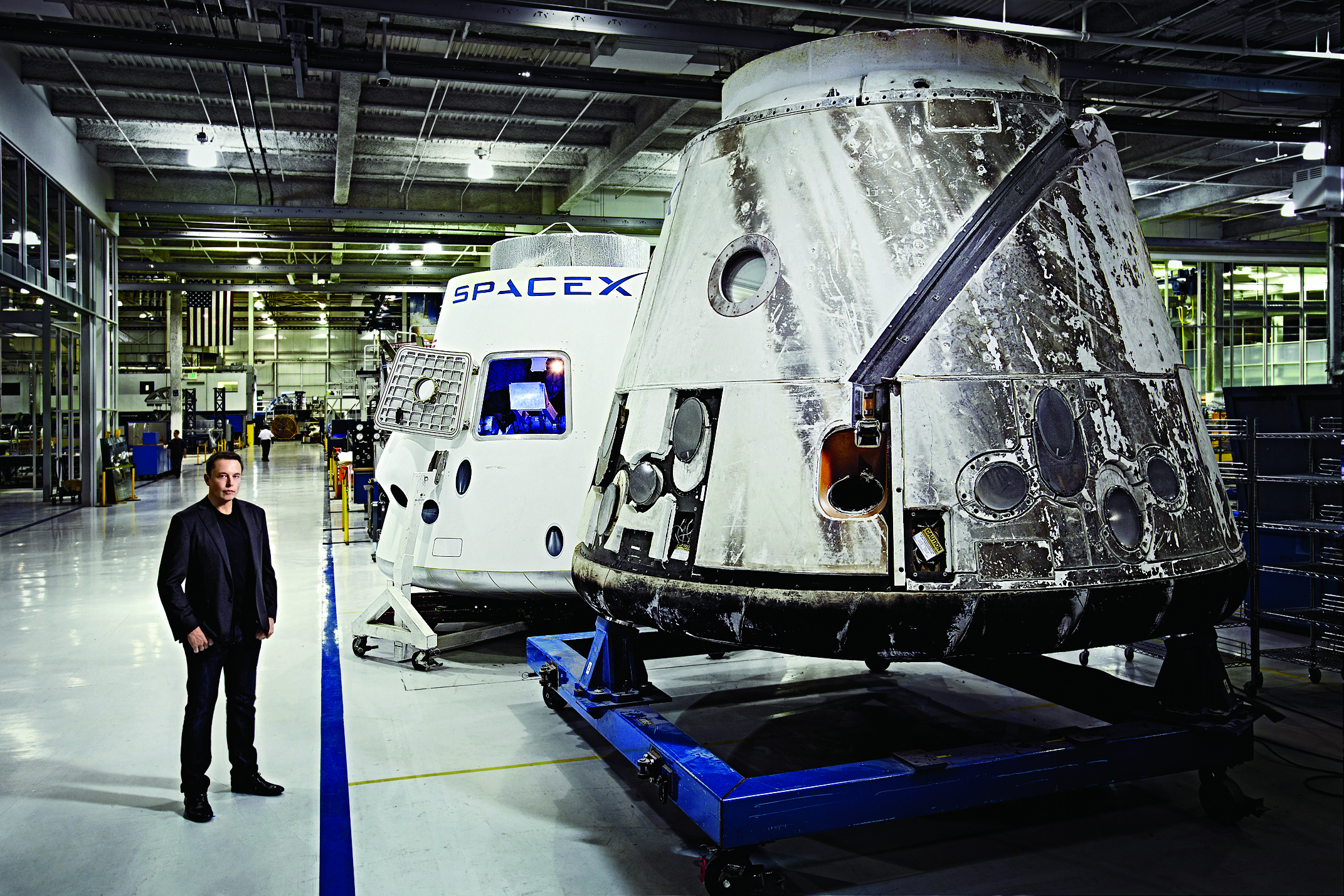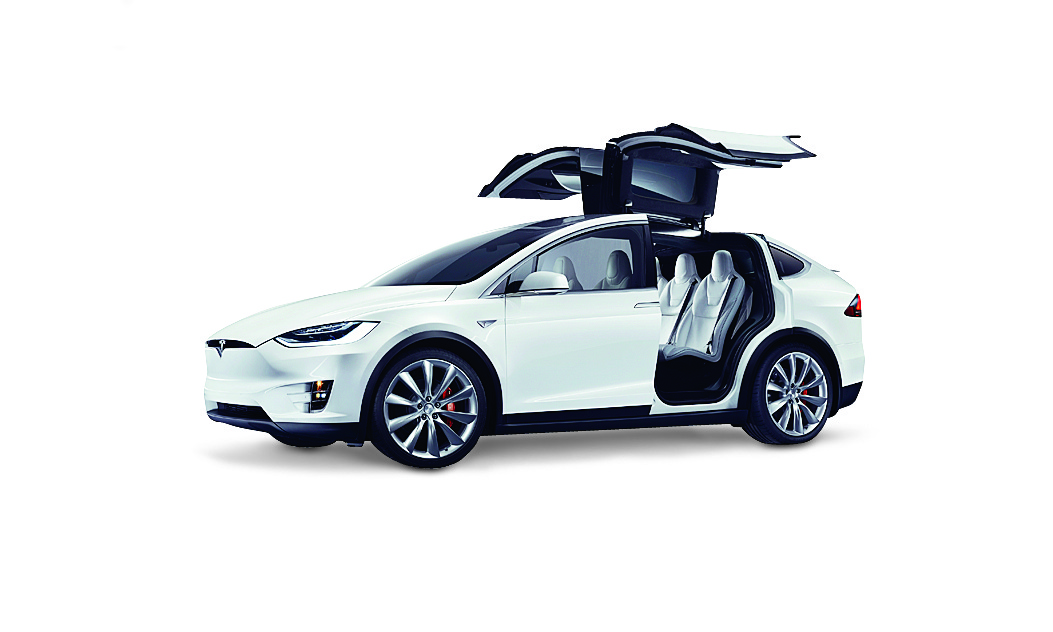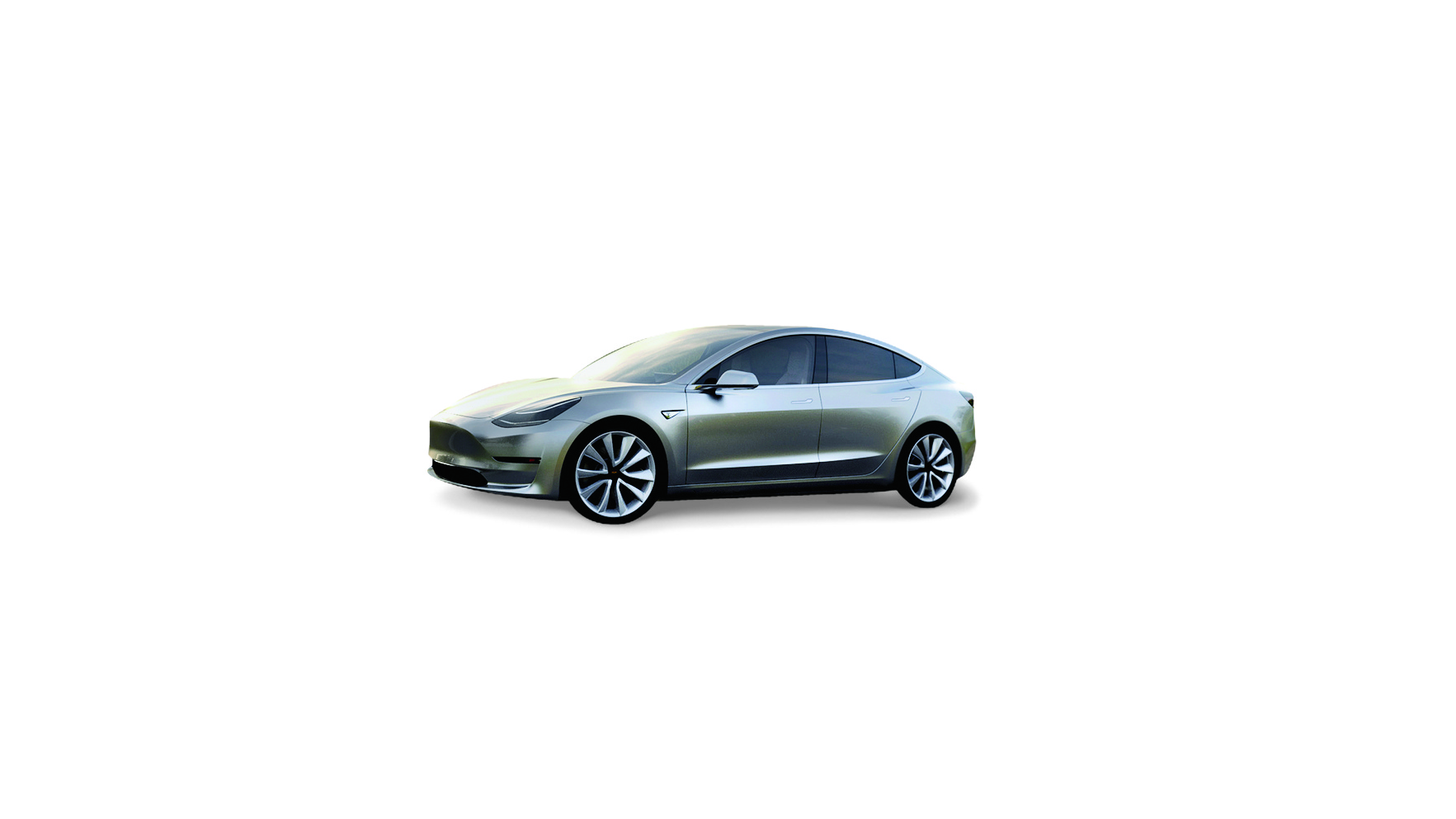Why Elon Musk Is The CEO of The Future
The visionary founder of Tesla and SpaceX is about to change life as we know it on Earth – and beyond.

There are no small mistakes when you’re in the business of launching rockets. One mechanical glitch, one wrong computer input and your exquisitely crafted, $60 million engineering marvel becomes a highly unsatisfying fireworks display.
Yet on the afternoon of September 28, 2008, as SpaceX’s Falcon 1 rocket sat on the pad at Kwajalein Atoll in the Pacific, the risks extended well beyond the impending launch itself. Elon Musk had boldly—foolishly, some of his own friends thought—sunk much of his Internet fortune into a commercial space company, which from an entrepreneurial perspective has a degree of difficulty right up there with nuclear fusion.
Now, after three consecutive RUDs (as in “rapid, unscheduled disassembly”), Musk was almost out of money. And he was certainly out of rockets. A fourth disaster would not only doom SpaceX but would likely take out Tesla, the electric car company Musk had also started. Tesla shared technology and overhead, not to mention Musk himself, with SpaceX and was hemorrhaging cash.
As Falcon 1 roared off amid the palm trees of “Kwaj,” a parallel roar of jubilation and relief emanated from SpaceX’s HQ in Hawthorne, California. Minutes after the flawless ascent to orbit, an emotional Musk turned to his rocketeers and said, “That was freakin’ awesome.” The successful mission would realize SpaceX’s strategy of utilizing low-cost, reusable rockets to launch satellites, deliver space cargo and ultimately carry humans to Mars. “There were a lot of people who thought we couldn’t do it. A lot, actually,” he told his employees. “But as the saying goes, the fourth time’s the charm, right?”
By late December of that year, just before Christmas, NASA was on the line telling Musk that SpaceX had won its $1.6 billion contract to resupply the International Space Station. “I couldn’t even hold the phone. I just blurted out, ‘I love you guys!’ ” he told 60 Minutes. And it wasn’t his only Christmas present. That month, Tesla had run down its cash so low that making the next payroll was doubtful—until a last-gasp infusion of investor money on Christmas Eve kept the company solvent. Before the Christmas Miracle, Musk thought he might be on the verge of a nervous breakdown.
Today, Tesla is on the verge of an enormous breakthrough. The introduction of Tesla’s Model 3 has been a triumphant, iPhone–level event, with buyers queuing for the privilege of purchasing the $35,000 electric vehicle two years in advance. The Model 3 is the culmination of Tesla Motors’ “Secret Master Plan,” one that Musk conspicuously posted on the company’s website in 2006. The idea was to first build the high-priced, $109,000 Roadster to prove the EV concept and finance the development of a family sedan, which became the Tesla Model S ($70,000)—the best-reviewed car in the history of the auto industry.
(In “Ludicrous” mode, it’s now capable of doing zero to 60 in 2.8 seconds, which Musk describes as “faster than falling,” and is quicker than most Porsches, Ferraris and Lamborghinis.) The Model S would then produce the funds for the lower-priced vehicle. In between, though, in 2015, Tesla announced the otherworldly, falcon-winged Model X SUV before it got to the Model 3, “so it’s a four-part trilogy,” Musk joked at the Model 3’s introduction this spring.

Jokes aside, Tesla has re-created the electric car, and to some degree the auto industry itself, by producing stylish, high-performance EVs without much help from Detroit, Tokyo or Stuttgart. Fanboys flock to his press conferences, and comparisons with Steve Jobs are not out of line. Tesla has taken in more than 400,000 orders for the Model 3, worth some $14 billion. The biggest challenge Tesla now faces isn’t selling the Model 3, it’s making enough of them. That’s known as a high-class problem.
Everything in Musk’s universe appears to be functioning optimally. In April, SpaceX stuck the ocean drone-ship landing of its reusable Falcon 9 rocket—think of a 12-story building parking itself upright on a floating doormat—which will be launching billions’ worth of satellites and space station shuttles for NASA, the International Space Station and other clients. “It’s another step toward the stars,” he said after the landing.
And far away from the stars, in the desert near Reno, Nevada, Tesla’s Gigafactory will soon double the world’s manufacturing capacity of lithium-ion batteries while increasing their efficiency and lowering cost. The Gigafactory will be churning out battery packs Musk says will make electric vehicles universally popular, reduce global warming and deliver cheap power to the poorest parts of the world. “It’s about a fundamental transformation of how the world works, about how energy is delivered across earth,” he said at the introduction of Tesla’s Powerwall home energy storage system last year. The initial goal: create a giant, distributed-energy utility across the United States to replace coal-burning power plants. He declined to patent the production technology, egging on other companies to use it to build more capacity.
Musk, 44, is a physicist and economist by training, and a jet pilot, self-taught rocket scientist and automotive and battery designer by avocation. His earliest success came as a transplanted South African (via Canada) code genie. He was one of the forces behind the formation of PayPal, a group that included Max Levchin, Peter Thiel, Reid Hoffman and others in the PayPal Mafia who would create Internet dynasties of their own-—the ultimate overachievers club. Unlike them, Musk wanted to move beyond Silicon Valley’s code culture to create physical products tied to space, energy and transport, and with a greater sense of responsibility to humankind.
It’s one of the reasons he formed SolarCity, a renewable-energy provider, and also what led him to post a white paper in 2013 on something called the Hyperloop. Born out of his frustration with California’s costly and slow proposal for high-speed rail between San Francisco and Los Angeles, the idea seemed outlandish at first: a podlike vehicle that floats in a nearly frictionless tube constructed between the two cities that would speed you along at 750 mph—and cost billions less than the existing plan. The Hyperloop capsule would hover over magnetic accelerators strung along the length of the tube, using a solar-powered motor for propulsion. Perhaps unsurprisingly, the physics have now been proven by one of several companies hotly pursuing the project, and Musk, too busy to run yet another startup, set his idea free to let others develop it.
What makes him remarkable is not that he believes that our carbon-based, CO2-spewing society is doomed. It’s that he’s dead certain he can do something about it. “The goal of Tesla and SolarCity is to minimize the existential threat of a delayed transition to a sustainable-energy economy,” he says.
SolarCity addresses energy supply, Tesla addresses energy consumption, and SpaceX is a sort of planetary insurance policy if Musk can’t save earthlings from their own destructive behaviors. “The purpose of SpaceX is to help make humanity multiplanetary. If life as we know it is multiplanetary, then the probable length of existence of human civilization is much greater,” he said after a recent rocket launch. No wonder Musk became the model for Iron Man in the eyes of actor Robert Downey Jr. Why be a mere money changer at PayPal when you can be an intergalactic force? Trying to rescue the planet can be remunerative, too. Musk is worth about $10 billion, the majority of it tied to his Tesla stock. He takes next to nothing in salary.
He may have been born brilliant and eccentric, but Elon Musk’s upbringing certainly contributed to the oddball genius label he’d acquire—even from his mother. Musk was raised in Pretoria, South Africa, the youngest son of a cold, distant engineer father and vivacious, entrepreneurial mother named Maye, a fashion model and nutritionist. In a society that prized athleticism, Elon had zero. From the time he could read he became a data input device, absorbing every book within reach. According to a Bloomberg report, he overcame his fear of darkness by doing the math. “Dark just means the absence of photons in the visible wavelengths—440 to 700 nanometers,” he reasoned. “It’s really silly to be afraid of a lack of photons.” (Try explaining that to your three-year-old.)

As a child, he designed backyard rockets and explosives to amuse his siblings and cousins; at 10, he got a Commodore computer, and his programming ability soon outstripped that of most adults; at 12, he wrote the software for a computer game named Blastar and sold it for $500. “I don’t think they realized I was 12,” he later recalled.
Elon, his brother, Kimbal (who later became a business partner), and sister, Tosca, were raised to be independent. At 17, he left South Africa for Canada, where his mother was born, and worked odd jobs while living with relatives. Maye and Kimbal would follow and the family made a home in Toronto, where Elon attended Queen’s University. He moved on to the University of Pennsylvania, earning degrees in both physics and economics, a rare and somewhat odd combination.
His pursuit of a Ph.D. in applied physics at Stanford would last a matter of days: Musk had already decided that universities delivered knowledge too slowly, and he had an idea that was turning into an itch. It was called Zip2. In 1995 the Internet was still an infant, but Musk realized that a tectonic shift was underway in publishing, from print to digital. He figured that local advertisers would buy space on the budding websites of local newspapers and developed Zip2 to do just that. He was way too early. Living hand to mouth, with brother Kimbal operating as sales chief, the pair hung on until print media companies finally began to see the light. That was enough to interest Compaq, which bought Zip2 for more than $300 million.
Musk already knew his next target—the stultified world of banking. “Money is low bandwidth. You don’t need some sort of big
infrastructure improvement to do things with it,” he told an audience at Stanford in 2003. He launched X.com with the idea of comp-letely transforming banking. But the PayPal guys were doing likewise, and after becoming quick and fierce rivals, the two companies eventually merged. Musk decamped to Los Angeles in 2002 and quickly began pursuing space exploration. The Hollywood setting suited both Musk and his wife, Justine, a woman he’d met and pursued at Queen’s University.
She became a novelist, magazine writer and blogger, documenting their lives in the Hollywood–Silicon Valley circuit. (Musk flew himself back and forth weekly.) Their Silicon celebrity lifestyle was tragically halted when their first child died of Sudden Infant Death Syndrome in 2002. They would later become parents of twins and then triplets—all boys—but the marriage could not stand the strain of Musk’s relentless dedication to his companies. He filed for divorce in the spring of 2008. Justine would make it all public in Marie Claire, calling herself a “starter wife.”
In 2009, six weeks after divorcing Justine, he became engaged to English actress Talulah Riley, who became wife 2.0, and then also wife 2.1: The pair divorced in 2012, remarried and then filed for divorce again. Musk is a big fan of iterations, but apparently it works better in manufacturing than in marriage.
Steering past potential business disasters to triumphant success is testimony to Musk’s idiosyncratic management approach. He has been called a nanomanager, someone who can see things on a mind-blowingly deep level. It comes from his physics background. “My main training and mind-set is that of a physicist,” he said. “So I tend to think of things in a physics framework, because I think that’s the best framework for critical thinking and for evaluating technologies that are fundamental.”

That background led him to believe that lithium-oxide batteries, which have a higher energy density than lead versions, could power a new era of electric vehicles. “The issue with existing batteries is that they suck,” he says. “They’re really horrible.” Tesla’s original cofounders, Marc Tarpenning and Martin Eberhard, had come to the same conclusion. Musk funded them and became chairman of the company, and then added a Li-ion battery pack he had also financed. Think of 10,000 triple-A batteries strung together powering your car. “If you could combine large-enough numbers of lithium-ion cells into a single battery, you could provide not only adequate range for a car but also power capable of turning the humble electric car into an object of desire,” he said at a TED talk.
Tesla owes a lot to SpaceX, where Musk was maniacally bent on lowering the cost of producing and launching a rocket, eventually cutting it down to $6 million dollars a pop. The nearest competitor charges $25 million. SpaceX’s approach is something that Musk cites often: rapid reuse. If you could design a low-cost rocket that could be fired, release its payload, land and be turned around rapidly, you wouldn’t have to reinvent the wheel (or the rocket), which is what NASA and large subcontractors such as Boeing have been doing for decades, at huge expense. “The cost to refuel our rocket, or reload—it’s mostly [liquid] oxygen—is only about two to three hundred thousand dollars, but the rocket itself is $60 million. It’s kind of like an aircraft. Aircraft are really expensive to construct and buy but not expensive to refuel, relatively speaking,” he explains. Rapid reusability can represent a hundredfold reduction in marginal cost.
That’s why SpaceX is building a Spaceport in Texas, designed to launch, land and relaunch rockets as rapidly as LaGuardia does 757s. The idea is to make space flight as unexciting as driving to the mall. “We’ll be successful, ironically, when it becomes boring,” he said after Falcon 9’s perfect touchdown. “When it’s like, ‘Oh yeah,
another landing, OK, no news there’—that’s actually when it will be successful.” And by then you can expect Musk to be long gone, throwing billions at some other adventure. Maybe to Mars. To make the point a little more real, SpaceX just announced that it would fire its Dragon spaceship at Mars, with a landing scheduled as soon as 2018. Musk won’t be a passenger, but he’ll be presenting his plans for Martian colonization at the International Astronautical Conference in Mexico this fall. “I think it’s going to sound pretty crazy,” he says with his typical dose of self-deprecation. “So it should be at least entertaining.”
